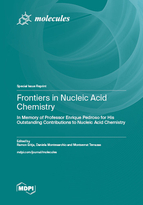Frontiers in Nucleic Acid Chemistry—in Memory of Professor Enrique Pedroso for His Outstanding Contributions to Nucleic Acid Chemistry
A special issue of Molecules (ISSN 1420-3049). This special issue belongs to the section "Chemical Biology".
Deadline for manuscript submissions: closed (30 June 2023) | Viewed by 25868
Special Issue Editors
Interests: nucleic acid chemistry; DNA and RNA analogs: synthesis applications, molecular tools; RNA interference; DNA nanotechnology; G-quadruplex; Triplex, artificial DNA
Special Issues, Collections and Topics in MDPI journals
Interests: oligonucleotides; nucleoside analogues; unusual structures of DNA; G-quadruplex; Ru(III)-complexes; Pt(II)-complexes; metal–DNA interactions; small molecule–DNA interactions
Special Issues, Collections and Topics in MDPI journals
Interests: nucleosides; therapeutic oligonucleotides; solid-phase synthesis; bioconjugation; delivery; cancer
Special Issue Information
Dear Colleagues,
Nucleic Acid Chemistry started soon after the Watson–Crick model of DNA with the synthesis of the first dinucleotide was published in 1955. However, in the last decade, this field has blossomed, with the demonstration that Nucleic Acid Chemistry can provide innovative solutions to new and old health problems such as vaccination, pathogen detection, and the treatment of metabolic or genetic diseases as well as providing important tools for the interrogation of cellular mechanisms. In this special issue, we would like to offer a few examples of novel developments in Nucleic Acid Chemistry and, at the same time, honour the memory of Prof. Enrique Pedroso, one of Spain’s pioneering researchers in Nucleic Acid Chemistry. His contributions to the synthesis of modified oligonucleotides, and especially oligonucleotide conjugates and cyclic oligonucleotides, opened up new avenues in the search for novel applications of oligonucleotides. In addition, Enrique was deeply involved in the research and promotion of Nucleic Acid Chemistry, as an active member of the IRT Society as well as organizing the Spanish Nucleosides Nucleotides and Nucleic Acids meetings (RANN). This Special Issue will be a tribute to his memory and a showcase of this highly interdisciplinary discipline that combines organic chemistry, biochemistry, pharmacology, materials chemistry, and biophysics.
Prof. Dr. Ramon Eritja
Dr. Daniela Montesarchio
Dr. Montserrat Terrazas
Guest Editors
Manuscript Submission Information
Manuscripts should be submitted online at www.mdpi.com by registering and logging in to this website. Once you are registered, click here to go to the submission form. Manuscripts can be submitted until the deadline. All submissions that pass pre-check are peer-reviewed. Accepted papers will be published continuously in the journal (as soon as accepted) and will be listed together on the special issue website. Research articles, review articles as well as short communications are invited. For planned papers, a title and short abstract (about 100 words) can be sent to the Editorial Office for announcement on this website.
Submitted manuscripts should not have been published previously, nor be under consideration for publication elsewhere (except conference proceedings papers). All manuscripts are thoroughly refereed through a single-blind peer-review process. A guide for authors and other relevant information for submission of manuscripts is available on the Instructions for Authors page. Molecules is an international peer-reviewed open access semimonthly journal published by MDPI.
Please visit the Instructions for Authors page before submitting a manuscript. The Article Processing Charge (APC) for publication in this open access journal is 2700 CHF (Swiss Francs). Submitted papers should be well formatted and use good English. Authors may use MDPI's English editing service prior to publication or during author revisions.
Keywords
- siRNA
- G-quadruplex
- DNA nanotechnology
- gene silencing
- aptamers
- drug delivery
- DNA
- RNA
- oligonucleotide synthesis









